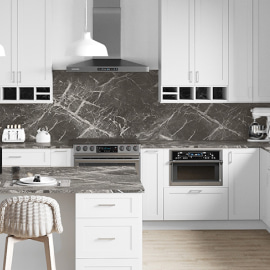
One of the best areas where you can begin your eco-friendly endeavors is the kitchen. Your cooking habits can have a significant environmental impact since the quantity of food that is wasted in the US each year requires the utilization of over 30 million acres of agriculture.
Fortunately, sustainable often means economical as well, so conserving resources will also save you money. Let’s see how you can do that.
- Eco-Friendly Paint
Is it time to freshen up the kitchen's walls? In this case, you can use only non-toxic paint. Materials like clay, milk proteins or citrus are used to create natural paint, which is devoid of solvents and has no volatile organic chemicals (VOCs).
To make your kitchen renovation more environmentally friendly, search for GREENGUARD-Certified paint when choosing the ideal shade. This paint helps lower indoor air pollution and the danger of chemical exposure.
- Select Green Flooring
If you're remodeling your kitchen and want to install new flooring, think about utilizing eco-friendly materials. Among the various flooring possibilities for an eco-friendly kitchen renovation are recycled tiles, bamboo, cork, and hardwood from responsibly managed forests. You won't have to give up beauty for sustainability, no matter what material you select.
Alvin Baker from Blending the Mix says that “Sustainability results in longevity. Investing in an eco-friendly choice will give you flooring that will last for a long time. This lessens the need for repairs and replacements. Thus, you are helping not only the environment but also your savings.”
- Substitute Countertops
A wonderful idea to make your kitchen environmentally friendly is to replace your countertops! For your countertops, think about utilizing recycled glass or even repurposed wood. These environmentally friendly materials are non-porous, long-lasting, maintenance-free, and don't require hazardous sealants.
They also don't chip or split easily. Another eco-friendly option that is long-lasting and recyclable is quartz, which is formed of natural materials.
- Replace Your Windows
Another eco-friendly kitchen update is replacing outdated windows. The heat transmission between the inside of your house and the outside is reduced thanks to environmentally friendly windows.
It has been demonstrated that replacing your windows with Energy Star-certified windows will save home energy costs by 12 percent. It also decreases greenhouse gas emissions.
- Pick Eco-Friendly Materials
Think about recycling existing materials while choosing new ones for your kitchen. Create floating shelves if you have excess wood from worktops or floors. Alternately, install dresser cabinet knobs on your new cabinets. You can design a gorgeous kitchen while preventing goods from ending up in landfills by refurbishing and reusing them where you can!
- Think About an Induction Stove
Want to buy a new stove? Choose an induction stovetop! By sending heat directly to the pan, this sort of burner shortens cooking times and conserves energy. Your kitchen will stay cooler if you install an induction cooktop since it will discharge less heat into the room.
- Cabinet Refacing
Are your kitchen cabinets in need of an upgrade? Consider giving your cabinets a facelift rather than replacing them totally as it has a considerably less ecological footprint than a full kitchen overhaul. This can save you money in addition to preventing waste from building up in landfills.
- Purchase a Convection Oven
In an attempt to have a green kitchen, you can also replace your outdated oven. You'll use roughly 20% less energy with a convection oven than you would with a regular oven. How? A convection oven includes a fan that continually circulates hot air to speed up cooking. Energy.gov mentions that “A toaster or convection oven uses one-third to one-half as much energy as a full-sized oven.” So, it also saves you money on energy bills.
- Upgrade the Light Bulbs
Simply replace all of your incandescent lights with LED bulbs to conserve energy in your kitchen! You may save up to $75 on your electricity bill by using energy-efficient bulbs, which consume up to 80% less energy.
In addition to utilizing LED bulbs, a dimmer switch might also help you save energy. Use windows for natural light and turn off the kitchen lights whenever you can!




